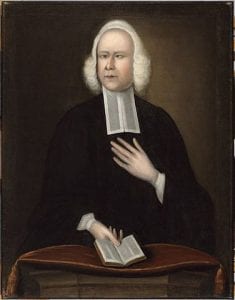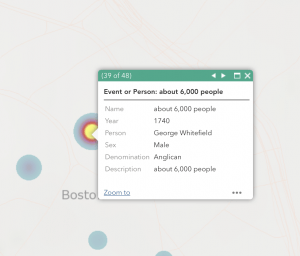The Great Awakening and George Whitefield
The Great Awakening and George Whitefield
By: Mallory Dean
For my project, I decided I wanted to track the Great Awakening through the preacher George Whitefield. While I’m doing this, I studied the madness that surrounded his sermons along with other aspects of his congregation. The Great Awakening was a series of religious revivals in the British Colonies in the early 1730s and 1740s. Historian Thomas Kidd argues that there was an increased “interest in corporate commitments to God and the covenant,” and an emphasis was placed on one’s personal relationship with God.[1] These revivals were led by various evangelical Protestant ministers, and were started by Johnathon Edwards in Northampton, Massachusetts. He believed that those in New England were becoming “far too concerned with worldly matters” such as wealth and property ownership.[2] This revolution against the beliefs and morals of those in New England sparked what became known as the Great Awakening. However, one of the more prominent preachers that stood out among them all was George Whitefield.

George Whitefield was a preacher that came to America from England, and began to tour the American colonies. He quickly became popular among the masses for his charismatic personality and passionate sermons.[3] Whitefield’s preaching style was relatively new to the colonists. In typical sermons, preachers would just drone on in almost a monotone way while they read passages from the Bible and recite prayers. However, George Whitefield would let his emotions shine through as he spoke, passionately yelling while he preached. Hearing about this new and interesting preacher and his new preaching style, thousands of colonists flocked from all over to hear him speak to the masses. So, affected by Whitefield’s preaching, the people would unleash “their emotions to make an immediate, intense, and personal connection with the divine”.[4]
This type of reaction to Whitefield’s preaching interested me, and I decided that I wanted to track the madness that seemed to follow Whitefield’s sermons and his preaching style. I also decided to track other aspects of his sermons such as crowd size, where he preached, and where the actual sermons were, to see if there was any connection between these aspects and the madness of his sermons. To do this, I researched various databases and found sources like journals and newspaper articles from around 1739 to 1765 when he was travelling that specifically talked about his sermons or the reactions people had to his sermons. Once I found an article or journal with useful information I documented data such as where the sermon occurred, how many people were there, and when it occurred. Once I put all of the information on a map, it will be easier to see how they are all connected.
One of George Whitefield’s most impactful sermons was in Boston at the Boston Commons. This particular sermon was so crowded, not everyone could get close enough to hear him. This resulted in pushing and crowding so severe that a few colonists even died during his congregation because of the “sheer madness” and desperation of the people who wanted to hear him speak.[5] This particular sermon was important, because it gives us a glimpse into the madness that tended to come with Whitefield’s sermons.

People were so passionate about Whitefield’s sermon and the message that he was preaching, that they were willing to put others’ lives at risk just to hear him speak. Another significant sermon of Whitefield’s was in Dublin, Ireland. Whitefield preached to thousands and thousands of people in a field, and said the congregation was so large it was “comparable to London,” which was the location of one of his largest congregations.[6] This particular sermon highlights the fact that Whitefield’s popularity was growing globally and not only in the colonies. The significance of Whitefield’s sermons as a whole proves the point that the Great Awakening was driven by the curiosity of the people and their interest in a religious revival. I believe that The Great Awakening taught people that they can speak out for what they believe in when it comes to their religion or when confronting belief issues in their congregation with their church. The Great Awakening also taught them that if their churches were not living up to their expectations, they could leave and form new ones where they could teach their own beliefs. The madness surrounding George Whitefield’s sermons shows just how much the Great Awakening had impacted the people’s religious views.
Works Cited
Kidd, Thomas S. The Great Awakening. New York: Basic Books, 2011.
“People & Ideas: George Whitefield.” PBS, Public Broadcasting Service, www.pbs.org/godinamerica/people/george-whitefield.html.
Whitefield, George. “Continuation of the Reverend Mr. Whitefield’s Journal”. Oxford, England. 1740.
“7b. The Great Awakening.” US History, Independence Hall Association, www.ushistory.org/us/7b.asp.
Notes
[1] Kidd, Thomas S. The Great Awakening. New York: Basic Books, 2011, pg 3.
[2] “7b. The Great Awakening.” US History, Independence Hall Association, www.ushistory.org/us/7b.asp.
[3] “People & Ideas: George Whitefield.” PBS, Public Broadcasting Service, www.pbs.org/godinamerica/people/george-whitefield.html.
[4] “7b. The Great Awakening.” US History, Independence Hall Association, www.ushistory.org/us/7b.asp.
[5] Whitefield, George. “Continuation of the Reverend Mr. Whitefield’s Journal”. Oxford, England. 1740.
[6] Whitefield, George. “Continuation of the Reverend Mr. Whitefield’s Journal”. Oxford, England. 1740.
